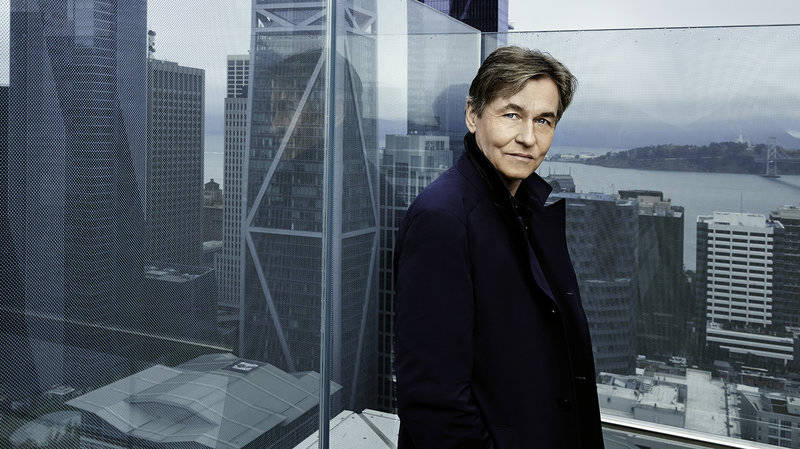“This is surprising in a very amazing and beautiful way,” said Jessica Bejarano, the director and conductor of the San Francisco Civic Symphony. “As far as I understood it, he retired from the L.A. Phil to focus on composition. I never thought he would return back to the podium as director. Great things are on the horizon for us.”
“Oh, really!” exclaimed Chris Lorway, executive director of Stanford Live, the arts presenter at Stanford. He then chuckled, “That’s exciting news.”
Lorway said Stanford Live, Cal Performances and the Salonen-led Philharmonia Orchestra collaborated on Dreamers, a project focused on young, undocumented immigrants. The piece debuts next March at UC Berkeley and Stanford.
The New York Times described Salonen as a tech-forward conductor, referring to him as a “disruptor.” Indeed, he worked with the London Philharmonia Orchestra on an app, virtual reality projects and immersive installations. The Times reported that one of the first meetings Salonen took in preparation for his new position was with roboticist Carol Reiley, whom he invited to serve as a collaborative partner for the symphony.
Yet Salonen’s appointment comes at a time when many corners of the arts community are chafing against the hiring of non-diverse leaders at major cultural institutions around the United States. A recent local example is the appointment of Thomas Campbell at the Fine Arts Museums of San Francisco. Campbell is an older, white man. So is Salonen.
Lorway said the issue of diversity in the classical music world is an age-old question and a major challenge. “It’s an issue which has to be grappled with it systemically,” Lorway said. “And I don’t know how you seed the pipeline in a way that results in changes the immediate future.”
“Who would the diverse choice be?” said Michael Morgan, the music director and conductor of the Oakland Symphony, and one of a small number of black conductors leading symphony orchestras in this country today.
Morgan applauded the San Francisco Symphony for its choice. “It’s kind of ideal for a major orchestra right now to have someone who’s an actual adult but has a youthful energy and spirit,” Morgan said. “This is a big thing with me: hiring conductors that are not too young, because it just takes so long to get to be any good at this.”
Morgan sees maturity as a more important consideration than ethnic background when it comes to the hiring of music directors.
“You don’t necessarily have to have diversity in the music director if you program with a diversity of approaches and outlooks in mind,” Morgan said. “The real test will be to see who shows up as guest conductors and composers and soloists at the San Francisco Symphony in the coming years.”
Lorway said he sees young conductors of diverse backgrounds starting to take up positions in orchestras around the world. “But I think for some of the major orchestras, especially in this country, I can see where there might be an inclination to go with the safer choice in some of these situations.”
Bejarano said it would have been amazing to see a woman such as Finnish conductor Susanna Malkki get the job. But she said Salonen is a “legend” and the right choice for San Francisco right now.
She takes the long view when it comes to diversifying orchestra leadership. “It doesn’t mean that this is going to be the standard for the rest of of history,” Bejarano said. “Minority conductors have to continue to push forward and never ever give up. Change in this situation is slow and gradual, and we just have to patient with the process. But it will change.”
Salonen himself acknowledges the challenges.
“I’m fully aware of the fact that I’m an old, white guy who deals with an art form that has deep European roots and is essentially something that was imported to this country 150 years ago,” said Salonen. “So I’m fully invested in trying to widen the horizon of this organization, not only in terms of reaching out to segments of the audience that that haven’t been coming to the concerts frequently, but also trying to develop the actual artistic content of the orchestra and the institution in such a way that the community would feel that the orchestra is doing something more relevant in their lives.”
Salonen and the San Francisco Symphony are bringing in eight collaborative partners from a variety of cultural disciplines to help address outreach and diversity in the organization’s programming. The group includes pianist, film producer, and composer Nicholas Britell; singer Julia Bullock, flutist and educator Claire Chase, composer and guitarist for the rock band The National Bryce Dessner, Finnish violinist Pekka Kuusisto, composer Nico Muhly, tech entrepreneur and scientist Carol Reiley, and bassist and vocalist Esperanza Spalding.
“I have this team of young artists who will be helping me not only in shaping the programs and the content of the symphony, but also to help me in finding ways to connect with the community,” Salonen said.
Current music director Michael Tilson Thomas will hand over the baton to Salonen in September 2020, when he will begin an initial five-year contract. Starting immediately, Salonen steps in as music director designate, leading the orchestra in a January 2019 program that includes Icelandic composer Anna Thorvaldsdottir’s Metacosmos, R. Strauss’ Also Sprach Zarathustra and Sibelius’ Four Legends from the Kalevala.
In 2020, Salonen will conduct the San Francisco Symphony for six subscription weeks and a tour of Asia. Starting in 2021, he will lead the orchestra for 12–14 weeks each season.


